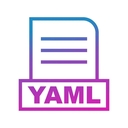---
document: this is doc 1
---
document: this is doc 2
YAML uses --- to separate directives from document content.
---
document: this is doc 1
---
document: this is doc 2
YAML uses --- to separate directives from document content.
parent: &defaults
a: 2
b: 3
child:
<<: \*defaults
b: 4
{
"parent": {
"a": 2,
"b": 3
},
"child": {
"a": 2,
"b": 4
}
}
# A single line comment example
# block level comment example
# comment line 1
# comment line 2
# comment line 3
n1: 1 # integer
n2: 1.234 # float
s1: 'abc' # string
s2: "abc" # string
s3: abc # string
b: false # boolean type
d: 2015-04-05 # date type
{
"n1": 1,
"n2": 1.234,
"s1": "abc",
"s2": "abc",
"s3": "abc",
"b": false,
"d": "2015-04-05"
}
Use spaces to indent. There must be space between the element parts.
YAML is a data serialisation language designed to be directly writable and readable by humans
.yaml or .yml extension
